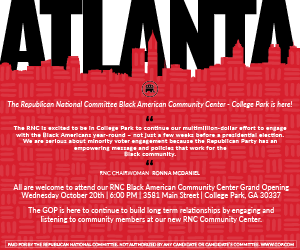on
Grace Stanislaus describes herself as a child and a product of the African Diaspora. She was born in the Caribbean, on the small island of Carriacou, which is a sister island to Grenada. And true to the story of many immigrants from the West Indies her family relocated to Brooklyn, NY. Her personal and professional journey has led her to extensive travels in Africa during her early 20s when she organized a show of contemporary African art for the Studio Museum in Harlem and another for the Venice Biennale, to directing the Museum of African Art, the Bronx Museum of the Arts, and the Romare Bearden Foundation in New York before relocating to San Francisco to direct the Museum of the African Diaspora. And now, by design, she’s in Atlanta, to take forward the National Black Arts Festival — an organization at the center of an incredible history and legacy.

There is much talk about the “death of the artist” as we know it and the birth of the creative entrepreneur; and that the “creative” we are seeing now is a composite figure who has to navigate the creative and consumer marketplace, often at the expense of Art. How would you articulate the utility of Art conceived and crafted in an African(a) genealogy … where it can be said that the form, function and purpose to culture at large is not achieved through disassociation?
This triggers memories of my years as curator at the Studio Museum in Harlem and also the re-examination of my career trajectory that led to Atlanta and my role as executive director of the National Black Arts Festival.
I’m reminded about the engaging conversations I had with artists in the museum’s artist-in-residence program — conversations about the creative process, artistic integrity, the lure of the marketplace, the commodification of art and of the artist and about how artistic success is defined and measured. These conversations took place in an institution that was established during the Civil Rights era of the 1960s primarily in response to the exclusion of artists of African descent from mainstream museums, collections and exhibitions, from representation by mainstream galleries and from art history books. The point is that there’s a parallel and an alternate history related to the experience of traditional and contemporary African and African-American art and artists. And their stories are often not framed around white privilege and access or the fall of the isolated artist/genius from an Ivory Tower.
So, what are we bemoaning about the so-called death of the artist as we know it and the birth of the creative entrepreneur? For centuries artists have been creative entrepreneurs in ways that were specific to the time in which they lived; they have been influenced, for good or bad, by patrons and the patronage system, have made artistic decisions based on access or lack of access to materials and support, and their work has been influenced by technological advances. For centuries artists have been in the marketplace, whether commissioned by the wealthy Medici family in Italy or by the tribal kings and chiefs in Nigeria or Ghana.
I’ve always been more interested in the alternative narrative. In this narrative pre-eminent African-American artist Romare Bearden is protesting outside of the Metropolitan Museum of Art to bring attention to the lack of people of color on the staff and at all levels of the mainstream institution. And in the alternative narrative Bearden is instrumental in establishing the Studio Museum in Harlem and the Studio Museum replaces the European patron and the patronage system, a system in which the lucky or the well-born or influential artist was made a member of the court and commissioned by Popes and wealthy noblemen.
From my vantage point, the emergence of the self-empowered artist, the artist who takes charge of his/her own career, who seeks financial gain and success within or outside of the marketplace, is a good story. Yes, some of us privately bemoan when any artist appear to lose their creative way or the work appears to cater too much to the appetites of the market. But if we remove the narrative from the vantage point of Western art history, the question becomes whose right is it to judge when the isolated “genius” has fallen from the Ivory Tower, especially if the story ends with the artist landing on solid financial ground and making a living and supporting his/her family?
Commodification, commercialization, co-option, consumerism, greed, lack of integrity are the dangers that lurks in the marketplace and at the center of the vortex of power and privilege whether in politics or the arts. But when a former Studio Museum artist-in-residence makes great work and is successful in the commercial marketplace, I feel like celebrating and taking credit for having been a part of the story.
And another point about the form and functionality of African art, all objects made in traditional African societies weren’t utilitarian or made by artists whose name, style and technique weren’t recognized or celebrated by the community. So much of Africa art and culture has been mythologized in this way in the Western imagination. Whether in Africa they used the European terms artist, artisan, craftsman, we can imagine that discussions about form, functionality, beauty, aesthetics and purpose were considered, if not discussed. And also that artists had conversations about the commerce of their trade and about getting paid by the Oba, king or chief for their masks or sculptures, most of which now grace the walls of our Western museums and galleries.
Many look to Atlanta to carry on the torch of the Black Arts Movement — notably during the NBAF’s 25th anniversary, it honored Amiri Baraka prior to his passing. How would you address this concurrent and at times collective need to see the past, present and future in Atlanta? What does it say about the potential of Atlanta?
Atlanta is carrying on the torch of the Black Arts Movement because the National Black Arts Festival continues to exist after 27 years and because our mission continues to focus on presenting and celebrating the contributions of people of African descent in all disciplines of the arts. From the very beginning, NBAF was aligned with the incredible flowering of Black literary, visual, performing arts and culture that defined the Black Arts Movement as it emerged in the United States in the 1960s in tandem with the Black Power Movement. Harlem, where Baraka established the Black Arts Repertory Theatre/School, was the center and catalyst of the Movement, and Atlanta was another because of the Civil Rights movement and NBAF. To celebrate the life of Amiri Baraka, one of the fathers if not the father of the Movement, during our 25th anniversary was simply coming full circle.
What you refer to as a collective need to see the past, present and future in Atlanta is for me embodied in the symbol of Sankofa. Among the Akan people of Ghana, Sankofa is represented as a bird whose head is faced in the opposite direction of its body. The symbol is interpreted as “We must go back and reclaim our past so we can move forward; so we understand why and how we came to be who we are today.” Learning from the past in order to move forward requires deep and honest reflection as well as the capacity for forward and progressive thinking and action. The question at its heart is, what lessons have the past taught us that can inform our decisions about the kind of world we want to leave our children and their children’s children? Georgia and Atlanta’s incredibly rich and complex history, including the state and city’s role in the Civil War and the Civil Rights Movement, offers a bounty of lessons to take forward as we shape the future today.
As executive director of the National Black Arts Festival, I think about the role of the arts and culture in this effort and about what we offer our stakeholders, audiences and especially our children, to prepare them to be stewards and supporters of our culture and cultural legacy.
What are several aspects of your upbringing — lessons, stories, experience — that you find yourself circling back to?
I circle back to my mother’s story, which is the immigrant story. It’s really a love story mixed in with a story about sacrifice and perseverance. My mother was the sole provider for seven children after her husband, my father, died young. And as is typical of the immigrant story she journeyed alone to make a life for us in Brooklyn, studied, became an LPN, worked hard, many extra hours, late at night, sent money back to the island so that we were well fed and clothed and eventually was able to gather all seven of us back to her in Brooklyn. Today, I’m blessed with a large family that includes five siblings, nieces, nephews, great nieces and nephews whose lives are all built on the shoulder of my mother. The lessons I take forward were instilled from my mother’s love and her work ethic.
I learned another formative lesson that shaped my values and defined my purpose and career trajectory during my time at Columbia University where I received my Masters degree and was trained as an art historian. I recall sitting in my art history classes and learning about Western, European and American art and seeing clearly the omission of the contributions of African and African-American artists from my courses and from the art history books. This realization led me down the path of educational self enrichment and of a deeper understanding and appreciation of the importance of organizations that were founded by African Americans as acts of self-empowerment from the Studio Museum in Harlem, the Harlem School of the Arts, to the Museum of the African Diaspora and even the HBCU’s.
Describe your inspirational lineage? What stories of men and women (past and present) have inspired you and why/how?
There are too many to name. But since arriving in the United States in the late 1960s, I’ve considered with greater awareness and appreciation the contributions of the trailblazers and luminaries of West Indian American and African-American heritage who have shaped American and world culture, whether acknowledged in the history books or not. I think about where we’ve come from with the dogs and hoses and the violence I saw on television as a child to a black president in the White House. Our story is an evolutionary story — immense progress forward has been made even though it often seems otherwise. AT
Join our email list to stay connected.







You must be logged in to post a comment Login